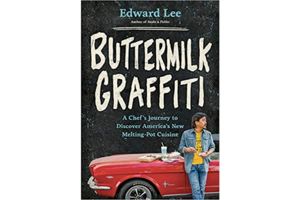'Buttermilk Graffiti' is a road trip in search of contemporary American cuisine
Star chef Edward Lee drives across the United States as he explores a mind-meltingly diverse world of food.

Buttermilk Graffiti:
A Chef’s Journey to Discover America’s New Melting-Pot Cuisine
by Edward Lee
Artisan Books
320 pp.
What is the flavor of America? It's easy to reflexively reach for the old standbys – the hot dogs, the pizzas, the apple pies, the picnic and street food that's everywhere and inescapable. It's also easy to look for that flavor at Michelin-starred restaurants in the big cities, or on television as curated by a few powerful celebrity chefs and producers.
Those answers aren't wrong, per se, but they miss a lot of the stuff that makes this country's gastronomic melting pot so expansive and nurturing. And that's the beauty of Buttermilk Graffiti, a new book by chef and author Edward Lee. The book's back cover touts its author's "layered perspective" (he's Korean-born and Brooklyn-raised with a strong professional and emotional connection to the cooking of the mid-South) and that's the key to the book's strength, too – it examines food not as static, finished recipes but as evolving conversations between cultures and generations.
Lee's exploration of the great gastronomic melting pot at this America manifests itself over 16 chapters and 40 original recipes, reflecting travel, research, and conversations as a mind-meltingly diverse world of food. Lee is consistently willing to dive into unfamiliar places and challenging conversations to get stories that haven't yet been told, and the reader emerges from "Buttermilk Graffiti" richer for his efforts.
In one of the book's most engrossing chapters, Lee travels to the Michigan city of Dearborn, famous nationally (and infamous among hard-right circles) as a place heavily settled by immigrants from the Middle East. He arrives at a time that is laden with meaning: It's the holy month of Ramadan, Muhammad Ali has just died, and a self-professed Muslim has shot up the Pulse nightclub in Orlando, Florida, killing 49 patrons.
With all of that on his plate, Lee decides to observe the sunrise to sundown Ramadan fast as he explores dozens of Dearborn's Middle Eastern restaurants, buying food from mostly empty restaurants during the day and eating them in his hotel room after dark. The chapter is an exploration of food, of religious observance, of immigration, and of cultural conversation, and it's an excellent read.
Another compelling section of the book is centered on the mill town of Lowell, Massachusetts, where Lee balances a remarkably old-school Lowell narrative (former boxer Jack Brady holding court in his bar, the Gaelic Club) with a story of new Lowell: a Cambodian restaurant called Simply Khmer. Lowell, Lee explains, has more Cambodian restaurants than New York City, and by digging into the stories behind Simply Khmer (and sharing a recipe for Amok Trey, a coconut curry featuring fish), he helps paint a continuous throughline of working class America from past to present to future.
As a native Wisconsinite, this reader particularly appreciated the way Lee handled a trip to the state in search of German food. He gets how good Wisconsin sausage can be. He gets that German food has been battered by prejudices (perceptions that it has to be clunky and heavy, and negative views created by the two World Wars.) He looks at how a lack of contemporary German immigration has sapped the cuisine of some vitality, while finding some remaining hot embers that illustrate how good it can be when practiced with love and skill.
In short: Lee talks a lot, but he listens more. More than anything, "Buttermilk Graffiti" represents exactly the kind of inquiry that helps create a vibrant national food scene. It's not a flavor-of-the-week Nutella lasagna recipe turned hashtag, and it's not a reality food competition. The book is one hyper-curious chef, on the road, meeting people in places that haven't already been covered to death and discovering what they eat and what makes it special.
Based on the stories that Lee tells, the journey was valuable unto itself – and we're just fortunate to get to tag along with him by traveling through the contents of this book.

